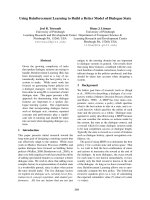Learning to read a non alphabetic script - chinese
Bạn đang xem bản rút gọn của tài liệu. Xem và tải ngay bản đầy đủ của tài liệu tại đây (750.44 KB, 16 trang )
Learning to Read a Non-
alphabetic Script -
Chinese
Or: “I have to learn
how many
characters?”
Basics of Chinese Characters
Represent a single syllable in the spoken
language
Usually a single morpheme, except for some
foreign loan words
Give some but not reliable phonetic
information
Often composed of other components – See
next slides
Total up to 50,000, but average educated
Chinese reader knows 3,500 to 5,000
Character Construction: 6
Methods
Pictographs
Pictographs 象形 : character is a picture
of what it represents 日 for sun and 月 for
moon. These were the first characters but
they make up a small total of the currently
used ones
Indicative
Indicative 指事 : character indicates by its
shape what it means, e.g. 二 means two, 上
means “up” and 下 means “down”
Character Construction (2)
Associative
Associative 会意 : Components combine
meanings into a new character, e.g. “sun” and
“moon” combine to 明 “ bright”
Phonograms
Phonograms 形会 : One component
(phonetic) contributes the sound, the other
(signific) the meaning. The most common class
of characters, totaling 85% of those in use.
E.g. 木 (wood) + 每 (
mei
) = 梅 (plum,
mei
)
Character Construction (3)
Meaning Expansion
Meaning Expansion 会注 : A
character’s original meaning gets
expanded
Phonetic Borrowing
Phonetic Borrowing 假借 : A
character is used for another word with
the same meaning, e.g. 萬 was
originally “scorpion” but now “10,000”
Some Myths
Chinese characters are a universal
writing system
Chinese characters are ideographs
(represent meaning directly)
Chinese characters are actually
“morpho-syllabic” and still largely
phonologically based
Differences between English
and Chinese
English letters correspond to phonemes while
sinographs correspond to syllables and
morphemes
Letters have a far fewer visually distinctive
features than sinographs
Chinese morphemes are almost always
monosyllabic, English allows more variety
Chinese words are often two or more
morphemes, with no word boundaries
indicated
Chinese uses many more graphic units
Learning to Read Chinese
(Van and Zian, 1962)
Starts with learning to read characters
Three stages
Relate sound/meaning to global shape of
character
Associate sound/meaning with parts of
characters, often confusing parts with
similar shapes
Associate sound/meaning with actual
character strokes
Learning to Read English
Four Phases (Ehri, 1992)
Pre-alphabetic – use visual clues with word
and in word
Partial alphabetic – readers use some of the
component letters of words and their sounds
Full alphabetic – Children can relate letters to
the sounds they produce (grapheme-
phoneme correspondence)
Consolidated alphabetic – “With repeated
exposure, particular letter patterns…become
multi-letter units such as onsets and rimes”
Comparison
Similarities
Learning both orthographies starts with
associating oral word with print stimulus
Learning is through paired associations
with various visual clues
Children then analyze words into their
components (letters or radicals)
Comparison
Differences
Phonemic awareness is a good predictor of
later English reading skills, but not in
Chinese
Knowledge of general information and
verbal memory is a good predictor of ability
to read Chinese and Japanese
Differences appear to be related to the
differences in orthography
An Owed to the Spelling Checker:
I have a spelling checker
It came with my PC
It plane lee marks four my revue
Miss steaks aye can knot sea.
Eye ran this poem threw it,
Your sure reel glad two no.
Its vary polished in it's weigh,
My checker tolled me sew.
Learnability of English and
Chinese
Is it harder to learn Chinese than
English?
It would seem so, since Chinese readers
have to learn so many characters
But that would indicate there should be
more reading disabled Chinese and that
they should be behind their English-reading
equivalents
But a study has shown this to be untrue
Learnability (2)
How can reading levels be similar
across languages?
Perhaps the orthographies really are well
suited for the languages
Each orthography has its advantages and
disadvantages that balance each other out
Perhaps switching to an alphabetic system
in China would bring its own problems
A Note on Romanizations
Various attempts have been made to
represent Chinese in an alphabetic script
Difficult because of tones and large number of
morphemes
Some systems include
Pinyin – uses Latin letters, tones indicated by
diacritics on top of vowel but easily left off
Guoyeu Romatzyh – Also uses Latin alphabet, but
tones represented in spelling









